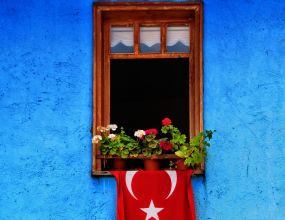
It is believed that the Roma left India in three groups, with the second group being the Lom. The Loms, settled in the lands south of the Caucasus, in Armenia, Georgia, Iran and Central Asia. In Turkey, Loms or Poshas adopted Islam in the 19th century and adopted Turkish culture. the Loms try to recognize themselves with their Armenian identity, which some historians attribute to the fact that Armenians have their own state.
It is believed that the Roma left India in three groups, with the second group being the Lom. The Loms, settled in the lands south of the Caucasus, in Armenia, Georgia, Iran and Central Asia. The Loms were anciently called Gnchu or Knchu. Today, Loms are called Bosha in Armenia, Boshebi in Georgia, and Posha in Turkey.
The origins of the Loms are more uncertain compared to other groups. The Loms separated from the Roma in the 11th century but did not migrate westward; instead, they settled in eastern Anatolia during the Seljuk and Ottoman periods. Many of them settled in the Sivas province. It is estimated that approximately 6,000 Poşa live in the city of Boyabat.
When the Ottomans besieged Yerevan, the Loms fought against them together with the Armenians. Most of them were wealthy Christian Loms from the Armenian Kond neighborhood. During the Armenian Genocide (1915), the Loms left the territories where they lived together with other Armenians.
During the Ottoman rule, Loms were considered Armenians. In the Ottoman Empire, the System of Nations was established to protect the rights of non-Muslim communities, granting certain autonomy to these confessional nations. Confessional nations included in this system had certain autonomy. Information about this can be found in the note written by the Armenian Catholicos about accepting the Loms as one of the Armenians, which was applied to the documents at the Berlin conference in 1878. "Kinchors" should not be separated from other Armenians in any way," said Catholicos. However, some Loms, particularly in the Tokat region, began converting to Islam.
The Loms, called Posha in Anatolia, adopted the culture of the place where they lived, like other Roma groups. However, the Loms are increasingly trying to integrate into the ruling groups. The Lom hardly use the Lom language. Homshetsi, Laz languages and Black Sea dialect speech are widespread among the Loms. Also, the Black Sea dialect is used among young people.
In the past, the Poşa were widely known for their crafts, particularly sieve-making and basket-weaving. Lom women primarily engaged in begging. Today, however, they are seen in various jobs and professions. According to a local Poşa legend from Turkey's Tokat region, the Poşa learned sieve-making from the Prophet Job.
In Turkey, Loms or Poshas adopted Islam in the 19th century and adopted Turkish culture. Currently, the Loms live in small communities predominantly in regions such as Kars, Ağrı, Van, Gümüşhane, Samsun, Çankırı, Kastamonu, Sivas, Erzincan, Erzurum, Hopa, Arhavi, Artvin, Ankara. and identify themselves as Meshket Turks, hiding their Lom roots. Additionally, a few Poşa families reside on Kurtuluş Street, in İstanbul.
Hiding Roma identities is considered one of the main problems of Loms, which is very visible among young people. According to Suat Kolukırık, the reason for this is the negative meaning of the word Posha, as well as the claims that the Loms have Armenian roots. Additionally, most of the Loms reject being called "Çingene" and assert that the name "Poşa" was given to their ancestors who were left without a home. In general, the Loms try to recognize themselves with their Armenian identity, which some historians attribute to the fact that Armenians have their own state.